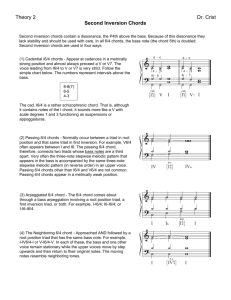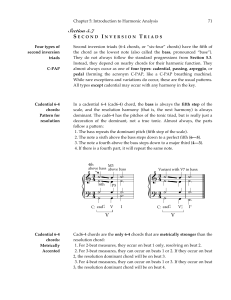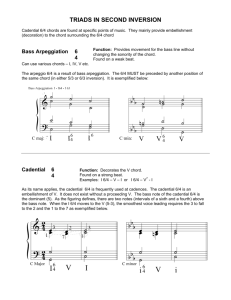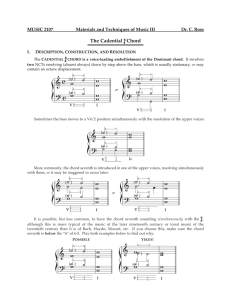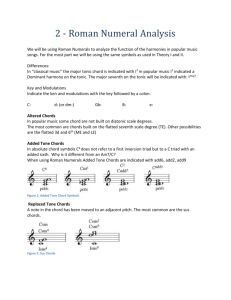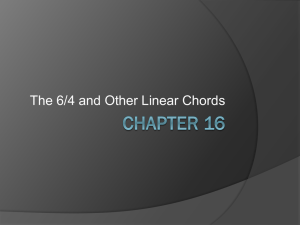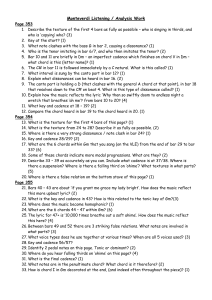6/4 Chords
advertisement
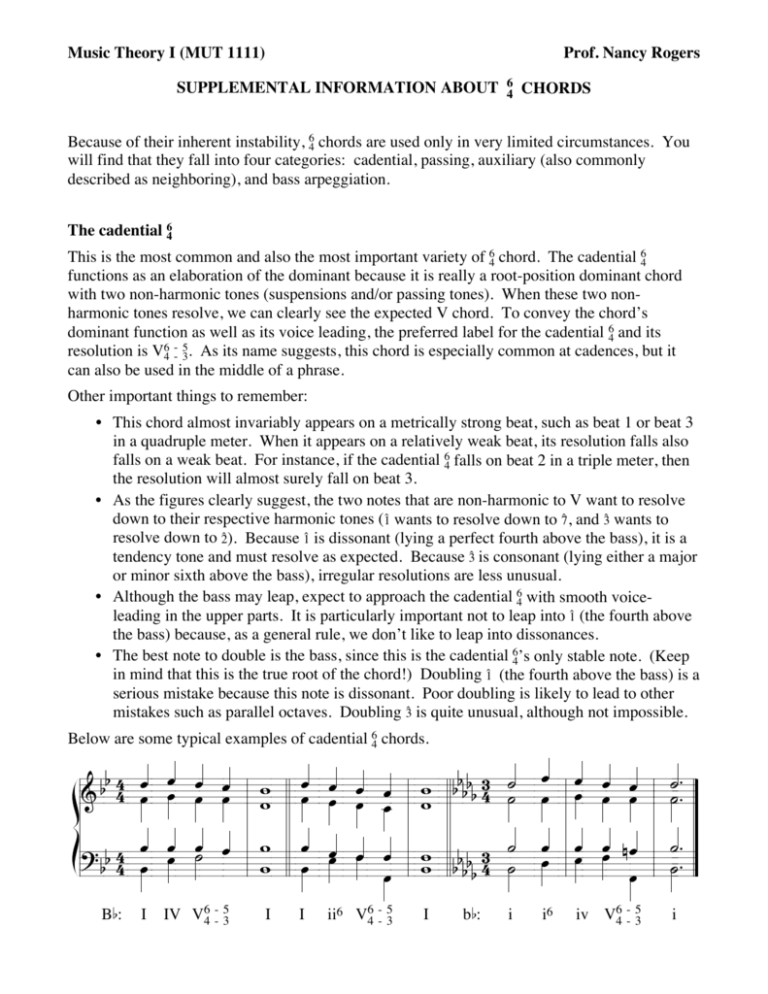
! Music Theory I (MUT 1111) Prof. Nancy Rogers SUPPLEMENTAL INFORMATION ABOUT 6 4 CHORDS Because of their inherent instability, 64 chords are used only in very limited circumstances. You will find that they fall into four categories: cadential, passing, auxiliary (also commonly described as neighboring), and bass arpeggiation. The cadential 64 This is the most common and also the most important variety of 64 chord. The cadential 64 functions as an elaboration of the dominant because it is really a root-position dominant chord with two non-harmonic tones (suspensions and/or passing tones). When these two nonharmonic tones resolve, we can clearly see the expected V chord. To convey the chord’s dominant function as well as its voice leading, the preferred label for the cadential 64 and its resolution is V64 -- 53. As its name suggests, this chord is especially common at cadences, but it can also be used in the middle of a phrase. Other important things to remember: • This chord almost invariably appears on a metrically strong beat, such as beat 1 or beat 3 in a quadruple meter. When it appears on a relatively weak beat, its resolution falls also falls on a weak beat. For instance, if the cadential 64 falls on beat 2 in a triple meter, then the resolution will almost surely fall on beat 3. • As the figures clearly suggest, the two notes that are non-harmonic to V want to resolve down to their respective harmonic tones (1̂ wants to resolve down to 7̂, and 3̂ wants to resolve down to 2̂). Because 1̂ is dissonant (lying a perfect fourth above the bass), it is a tendency tone and must resolve as expected. Because 3̂ is consonant (lying either a major or minor sixth above the bass), irregular resolutions are less unusual. • Although the bass may leap, expect to approach the cadential 64 with smooth voiceleading in the upper parts. It is particularly important not to leap into 1̂ (the fourth above the bass) because, as a general rule, we don’t like to leap into dissonances. • The best note to double is the bass, since this is the cadential 64’s only stable note. (Keep in mind that this is the true root of the chord!) Doubling 1̂ (the fourth above the bass) is a serious mistake because this note is dissonant. Poor doubling is likely to lead to other mistakes such as parallel octaves. Doubling 3̂ is quite unusual, although not impossible. Below are some typical examples of cadential 64 chords. % 4 & & & & ! & & & & ! %%%% 3 ' & & & & ' ( % % 4 ' & & & & '$ ( $$$$$$$$$$$$$$$$$$$$$$$$$ " 4 & & & & ! & & & & ! & & & ! & ' & & & '( %% 44 & & ' & ! & && & & !! %%%% 34 ' & & & ) & ' ( $$$$$$$$$$$$$$$$$$$$$$$$$ # % & & $ B b: I IV V64 -- 53 I I ii6 V64 -- 53 I b b: i i6 iv V64 -- 53 i The passing 64 This is the second most common variety of 64 chord. However, it is not a strong chord and has no real purpose except to lead between stronger and more important chords (almost always two tonic chords or two pre-dominant chords). To convey the passing 64’s marginal status, it is preferred simply to label the chord “P64” for several reasons: it is too weak to deserve its own Roman numeral, its root is essentially irrelevant, and it helps avoid confusion with the cadential 64. Alternatively, some people place the Roman numeral (either V64 or I64) within parentheses to convey the chord’s relative unimportance. Other important things to remember: • This chord always involves a stepwise bass line, and usually very smooth upper voices as well. Voice exchanges between the bass and an upper voice (frequently the soprano) are common. Leaps in the upper voices are unusual, and leaps in the bass are impossible. • This chord tends to occur between two inversions of the same chord (e.g., I and I6). Otherwise, it will connect two very similar chords (e.g., IV6 and ii6). • Since the chord is weak and shouldn’t attract much attention, it is likely to fall on a metrically weak beat. The chord that immediately precedes the passing 64 will almost surely fall on a metrically strong beat (probably a downbeat). • Doubling the bass will almost surely produce the best and smoothest voice-leading. Any other doubling is rare. • Passing 64 chords almost always expand either the tonic function or the pre-dominant function. They almost never expand the dominant function (because there are other chords that better fulfil this role). Below are some typical examples of passing 64 chords. Don’t be alarmed by the inner voices: C-Gb is a d5, so there are no parallel fifths! %% 4 ' & & %% 34 && && && %%%%% && ) && && %% & & % %% 4 ' & &$ $$$$$$$$$$$$$$$$$$$$$$ " & & & & & & % & & & & & & ' & & 3 %% 4 & & & % %% & & & %% & & & %%%% 44 ' & & $$$$$$$$$$$$$$$$$$$$$$ # % % $ B b: I P64 I6 b b: i6 P64 i B b: IV P64 IV6 Notice the voice exchanges that occur between the bass and some upper voice (often the melody). b b: iv6 P64 iiº6 When realizing this progression, the above melody is almost always best. The neighboring 64 (also known as the pedal 64 or the auxiliary 64 ) Although this chord is distinctly less common than either the cadential 64 or the passing 64, it is by no means unusual. Like the passing 64, this chord serves only to expand the chords around it. Like the cadential 64, it is really a root-position chord with two non-harmonic tones (upper neighbors); the chord tones we expect in the upper voices will almost always occur immediately before and after the 64 chord. To convey the neighboring 64 chord’s function as well as its voice leading, the preferred label involves the figures 53 -- 64 -- 53. Other important things to remember: • The neighboring 64 involves a stationary bass line (and usually one stationary upper voice), while two upper voices step up and step back down again. • It almost always expands either the tonic or the dominant. Expect to see a very typical root-position tonic or dominant chord both before and after the neighboring 64. • The best note to double is the bass, since this is the chord’s only stable note. Any other doubling is rare. • Since the neighboring 64 chord is weak and shouldn’t attract much attention, it is likely to fall on a metrically weak beat. The chord that immediately precedes it will almost surely fall on a metrically strong beat (probably a downbeat). Below are some typical examples of neighboring 64 chords. % 3 & & & %% % %% 4 ' & & % % % % & % & & % && && && & & & % % 4 ' & &$ $$$$$$$$$$$$$$$$$$$$$$ " 4 & & & && && && & & & & & & ) '' && && 3 4 %% 4 & & & %% % & & & %% % % %%% 4 %% $$$$$$$$$$$$$$$$$$$$$$ # $ B b: 6—5 I 53 — —4—3 6—5 b b: i 53 — —4—3 6—5 B b: V 53 — —4—3 b b: 6—5 V 53 — —4—3 The bass arpeggiation 64 Usually you will realize that these are not genuinely independent chords, but are instead a byproduct of a vaguely melodic (or at least active) bass line. It is therefore usually most appropriate not to label such 64 chords individually. Below are some typical examples of bass arpeggiation 64 chords. %4 ! %%% 4 ! 34 ' ( ! % % 4 % 4 ! ' ( ! !$ $$$$$$$$$$$$$$$$$$$$$$ " !& ! 4 & & ' 34 ' ( & & %% % 44 !& & & & %% 4 !$ %% $$$$$$$$$$$$$$$$$$$$$$ # & B b: I -------------- B b: V ------------ b b: i ------------------------- One final example containing all types of 64 chords *3 && && && & & & & ' ( ' ' 4 $$$$$$$$$$$$$$$$$$ " & & & '( ' & & & & & & & '( & & *3 & & & $$$$$$$$$$$$$$$$$$ # 4 ' & & & & & G: 6 —— 5 I 53 — — 4 —— 3 P64 I6 5 ii6 V64 — —3 I -----------
